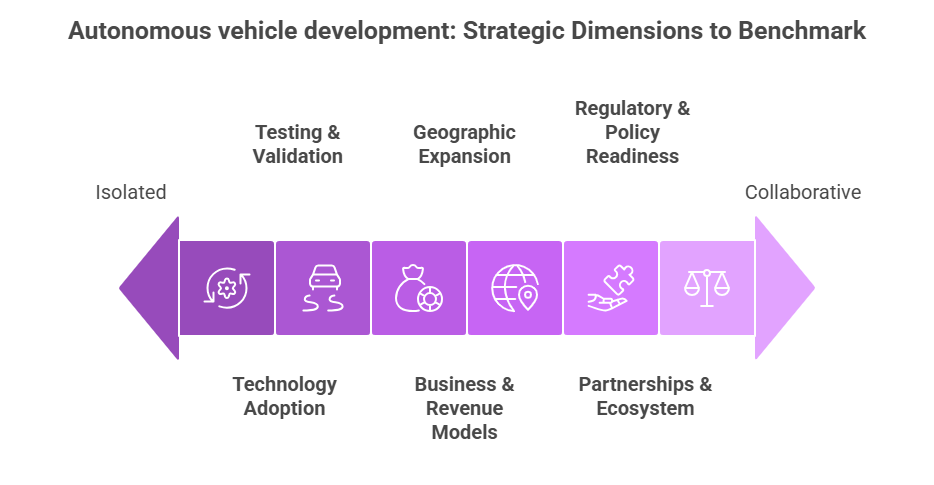Autonomous mobility isn’t “coming soon”, it’s already reshaping how the world moves. With global road transport contributing over USD 7 trillion annually, the companies that win this race will be those who understand competitors’ moves before they become visible.
Yet most automakers still operate with partial visibility. They track press releases, pilot launches, or hardware choices, while missing the deeper signals that shape long-term dominance.
This is where Nexdigm’s Autonomous Vehicle Strategy Benchmarking gives leaders the foresight they need to invest smarter, partner better, and move faster in a high-stakes decade.
Why Strategy Benchmarking Matters in Autonomous Vehicles
- Avoid Competitive Blind Spots: Global automakers and tech giants have already invested USD 100+ billion into AV R&D.
- Stay Ahead of Regulatory Shifts: UNECE safety amendments increased compliance requirements by 30–40% for Level 3 autonomy.
- Strengthen Ecosystem Positioning: AV growth depends on collaboration. Telecom 5G rollouts now cover over 2 billion users, altering V2X capabilities.
- Boost Investor and Stakeholder Confidence: With AV pilot projects crossing 10 million+ autonomous test miles, leaders must show credible, data-backed roadmaps.
Strategic Dimensions to Benchmark

- Technology Adoption: Compare how peers are advancing in AI models, sensor fusion, LiDAR vs camera-first approaches, and V2X communication. This reveals which tech stacks are maturing fastest and where gaps exist.
- Testing & Validation: Benchmark on-road miles, simulation hours, and safety records. For example, U.S. and Chinese players have logged millions of autonomous testing miles, setting new industry benchmarks.
- Business & Revenue Models: Evaluate whether competitors pursue robo-taxi fleets, licensing AV software, subscription models, or mixed-use deployment. This clarifies monetization pathways.
- Partnerships & Ecosystem: Assess collaborations with telecom providers, insurers, smart cities, and tech giants. Benchmarking ecosystem strength helps leaders decide between building independently or co-developing solutions.
- Geographic Expansion: Review how companies approach global rollouts. U.S. players face state-level regulation, EU emphasizes harmonized safety standards, while China accelerates approvals via pilot cities.
- Regulatory & Policy Readiness: Benchmark compliance with regional safety laws and sandbox programs. Leaders gain insight into who is moving faster under UNECE, EU, or U.S. DOT frameworks.
The Nexdigm Difference
Nexdigm helps automotive leaders decode:
- Which technologies merit investment (LiDAR vs. camera-first vs. hybrid)
- What partners accelerate entry — telecoms, AI labs, fleet operators
- Where regulatory windows open fastest
- How top players validate, commercialize, and scale autonomy
Our benchmarking frameworks blend competitive intelligence, global regulatory tracking, commercial modeling, and ecosystem mapping, giving leaders the foresight to plan one decade ahead.
Nexdigm Case
Nexdigm helped a global automotive supplier benchmark 14 AV players across the U.S., EU, and China, analyzing 80+ feature models and regulatory paths. Within four months, the client realigned its AV roadmap, fast-tracked two high-value features, and avoided USD 22 million in projected R&D waste. Thus, proving how benchmarking accelerates smarter AV decisions.
To take the next step, simply visit our Request a Consultation page and share your requirements with us.
Harsh Mittal
+91-8422857704

